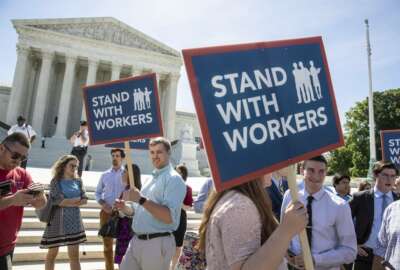There are a lot of reasons why the majority of federal workers do not belong to a union. Some don’t like them or genuinely feel they don’t need them. Some may be unaware that there are unions in their agency, while others may just be too cheap to pay the dues which, by private sector union standards, are very low.
There are also a lot of reasons why the minority of civil servants are dues-paying union members. They may want to pay their fair share for whatever benefits the unions win for them or protect. They may be grateful for what unions have done in the past. Maybe they are intensely afraid of the Trump administration, especially if they work for the Social Security Administration, Department of Justice, Environmental Protection Agency, or the departments of the Interior, Housing and Urban Development or Veterans Affairs?
The recent court ruling against the administration’s crackdown by executive order against federal unions delighted some people inside government. Others think the decision by a federal judge appointed during the Obama administration is highly political.
Among other things, the judge directed agencies that had cracked down on official time to return to amounts allowed before the Trump administration changes. Official time is when the government pays a portion of their salary while they are conducting legitimate union business such as inspections, grievances and health and safety matters. Agencies were also ordered to let union officers return to government-owned union offices from which some were evicted as a result of the EO. How soon that happens could vary greatly agency-by-agency.
Now that official time is back, at least until the next court ruling if there is one, it’s interesting to run down the history of official time and the potential costs to nonunion members if it is eventually revoked.
During the debate and design of the Carter administration’s civil service reform plan, unions asked for something called “representation fees.” Those fees would have been charged to nonunion members if they are in a bargaining unit that covers all employees whether or not they belong to a union. The idea was that the fees — less than the amount of full dues but still potentially hefty — would be used to reimburse the unions for work they did representing nonmembers. Estimates of those costs vary each year, but even the lowest are a lot.
A former union official said that at the time representatives of the Carter administration and/or congressional Democrats convinced unions to accept official time. This was less politically explosive and cheaper than charging nonmembers biweekly representation fees. Since millions of dollars were involved, and the unions didn’t want the blowback from angry nonmembers, they accepted official time. It turned out to be a brilliant move for them.
Wednesday on our Your Turn radio show Federal News Radio’s Nicole Ogrysko will talk about the labor-management changes that the court has disallowed, what they might have done to federal employees and what the return to the status quo means for the future.
Later on, reporter Jory Heckman will talk about the data which indicates that large numbers of federal scientists are leaving the government, why the mini-exodus and what it means. The show airs 10 a.m. EDT on www.federalnewsradio.com or 1500 AM in the D.C. area.
Nearly Useless Factoid
By Amelia Brust
Moving sidewalks may have been synonymous with airports since the mid-20th century but the technology was known even earlier. A “moving pavement” transported people between exhibits during the Paris Expo in 1900 and science fiction novelist H.G. Wells even mentioned them in his 1899 tale “A Story of the Days to Come.”
Sources: USA Today and QI
Copyright
© 2024 Federal News Network. All rights reserved. This website is not intended for users located within the European Economic Area.
